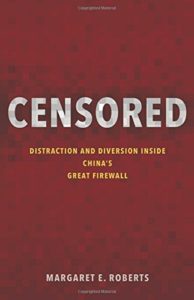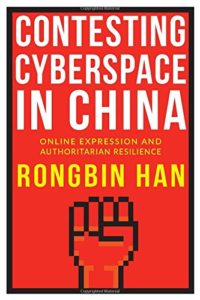 Review of Censored: Distraction and Diversion Inside China’s Great Firewall by Margaret Roberts. Princeton, 2018, and Contesting Cyberspace in China: Online Expression and Authoritarian Resilience by Rongbin Han. Columbia, 2018.
Review of Censored: Distraction and Diversion Inside China’s Great Firewall by Margaret Roberts. Princeton, 2018, and Contesting Cyberspace in China: Online Expression and Authoritarian Resilience by Rongbin Han. Columbia, 2018.
The internet was supposed to have delivered China into freedom by now. But that optimistic consensus has been proven wrong so far. In their books, academics Rongbin Han and Margaret Roberts, attempt to explain why.
Han, an assistant professor at the University of Georgia, was a student at Peking University when the internet’s impact first began to be felt on campus and in broader society. But the vibrant discussions the internet initially spurred would prove too much for the ruling Communist Party, which, over time, has become more sophisticated in reasserting information control.
To frame the internet and its users in opposition to the government, Han warns, misses its real effect. The internet enables a pluralization of discourse – meaning that, even though the state is not always leading the conversation, netizens’ diversity of opinion, including many who genuinely support the state, work against any concerted effort against the regime. Han is an often amusing guide to the factions, rhetoric, and bewildering slang that dominate online debate. He explains the official “50-Cent Army” of paid commentators who promote the government’s viewpoints, and the unofficial one of pro-Party netizens who frequently attack government critics as pawns of the West.
Han is clearly still enthralled by the online bulletin boards through which he first encountered the internet. But his nostalgic attention on Web 1.0 neglects the Web 2.0 of social media, chief among them WeChat. In researching the Chinese equivalents of Reddit or 4chan, instead of Facebook, Han is drawing conclusions on the basis of polarized internet subcultures not necessarily representative of the Chinese internet as a whole. Nonetheless, his timeline of Chinese internet regulation, the various agencies involved, and his in-depth look at the “50-Cent Army” are insightful.
Where Han’s approach is ethnographic, Roberts’ is sociological and data-driven. Roberts, an assistant professor at UC San Diego, argues that the government recognizes it cannot possibly control all of the internet. Instead, it engages in a “porous censorship” that targets the most sensitive content and seeks to keep all but the most motivated from accessing it. (Her research suggests these tend to be the more educated and wealthy, with a strong interest in politics.)
Roberts is one of several rising academics who stress that China is just part of a broader interest in authoritarian regimes and practices, even though the country is the subject of their most significant work. Consequently, nearly half of her book is spent on a general treatise on censorship before summarizing her published research on China’s internet.
China and other authoritarian governments face three choices when seeking to control information. They can use fear, including overt censorship or punishment; “friction”, any effort to discourage access to information; or “flooding”, an attempt to guide and distract citizens with other information. Authoritarian regimes are often reluctant to use fear because it can backfire, inflaming opinion and drawing attention to the topics it had hoped to suppress. (Roberts’s unique research demonstrates that censorship actually increases the likelihood a user persists in posting about that topic.)
Friction and flooding are China’s preferred means of controlling information. When even small delays can lead to big drops in user attention, raising the cost of accessing information even a little can deter most citizens from seeing what the government doesn’t want them to see. According to her research, most internet users don’t even know the Great Firewall, which blocks scores of websites and sensitive terms, exists. Only 30% know and just 5% have “jumped the firewall” by acquiring a VPN, a service which allows users to access unrestricted sites.
Both books speak to the conflicted role of private companies, which have been co-opted by the state’s censorship apparatus into employing thousands of private censors. In return, the government’s firewall protects its domestic internet industry. Roberts estimates that Twitter has 1-2% of the market share it would have were it not blocked; despite the block on Facebook, an estimated 52 million Chinese have accounts. But Roberts notes that censorship is also a tax on China’s tech sector, both because they must hire small armies of censors to police their sites and because the firewall can limit interaction with the global tech community. Unfortunately, neither book offers insight on Chinese consumers’ growing demands for internet privacy, and how this will test the partnership between the state, which wants access to all data, and internet companies, which must balance accountability to its users, investors, and the government.
There is much else that one wishes both authors had addressed. While both books reference examples of vitriolic nationalism, neither speak much to the role the internet has played in creating a more benign form of national connectedness, witnessed by the growth in online charity. Neither book explores what China’s claims of “internet sovereignty” mean for the evolving global governance of the internet and ignore last year’s crackdown on VPNs.
Recent events demonstrate that for all its controls, the internet has placed the Party on a permanently reactive footing. After Weibo, China’s Twitter-like service, banned gay-themed posts in an effort to comply with government censorship directives, gay Chinese and their allies vocally demanded that the policy be overturned. Within days, the company had changed course. On college campuses, students, inspired by the global #MeToo movement, have brought back to light the 1998 suicide of a Peking University student precipitated by a professor alleged of raping her. They have also come forward with their own experiences of misconduct and demands for justice.
The former protest, targeted at a private company, succeeded so effortlessly in part because it never left the realm of the virtual; the latter, because it threatened collective action against an organ of the state, swiftly invited online censorship and offline pressure. But, consistent with Roberts’s research, that only invited further outcry and attention. Even as the news has been censored, several accused professors have been let go. Even if the government manages to suppress the news online, the protesters are winning offline.
In retaliation for the massive hack of a database of government personnel attributed to China in 2015, the Obama administration considered directly attacking China’s Great Firewall. But the United States is neither beyond reproach and in some cases more challenged by the internet than China because of its very commitment to freedom of speech.
The internet has disappointed the cause of democracy in the West too. From Menlo Park to Capitol Hill, reasonable people are struggling to manage the epidemic of fake news (it would come as no surprise to Roberts that Facebook’s recent attempts to label suspect news only increased the likelihood it would be shared). The darkest corners of the internet harbor and inflame the hate witnessed in Charlottesville and Charleston, while even the most respectable fora seem capable only of division. Technological monopolies and developments have raced ahead of Western governments’ ability to regulate them in protection of consumer privacy; in China, these developments have been readily exploited to give the government greater ability to police its people.
In reading Han and Roberts’s books, it is surprising how startling the recognition that the internet is proving to be just as much a challenge to democratic civil societies as it has been unexpectedly manageable by the world’s foremost authoritarian government.
This review was originally published with the Asian Review of Books.